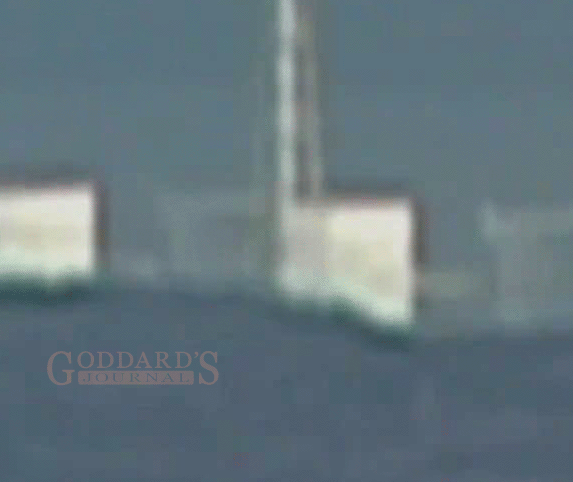SUBHEAD: West Coast and Hawaii were hit by radioactive plumes of uranium/plutonium from Fukushima explosion.
By Admin on 3 February 2015 for ENE News -
(http://enenews.com/japan-govt-experts-west-coast-hit-radioactive-plumes-both-massive-explosions-fukushima-maps-showing-la-san-francisco-covered-red-cloud-removed)

Image above: Animated GIF simulation of Fukushima Daiichi #3 Reactor explosion releasing contents of reactor into atmosphere superimposed on actual video. From (http://iangoddard.com/fukushima01.html).
The West Coast was hit by radioactive plumes from both massive Fukushima explosions — Maps of L.A. and San Francisco covered in red clouds removed from latest paper — Total releases ‘clearly larger’ than previously claimed — ‘Significantly’ higher discharges flowed toward U.S.
 Image
above: Mapping of western Pacific Ocean and California showing Cesium surface distribution in late March 2011. From original article.
Image
above: Mapping of western Pacific Ocean and California showing Cesium surface distribution in late March 2011. From original article.
Excerpts from study by scientists from Japan Atomic Energy Agency, Japan Meteorological Agency, NOAA, UK Met Office, Canadian Meteorological Centre, 2014-2015 (emphasis added):
Video above: Explosion at Fukushima Daiichi Reactor #3 appears to eject massive amounts of nuclear fuel. From (http://youtu.be/1Q3ljfLvHww). UPDATE from Ian Goddard on 4/21/11: I now believe the best explanation for Unit 3 is an ex-vessel steam explosion (http://iangoddard.com/fukushima01.html). A steam explosion does not exclude a nuclear criticality as considered in this video (in fact the explosion of the Borax test reactor was both a criticality and a steam explosion (http://youtu.be/8WfNzJVxVz4?t=13m27s), but at the same time a steam explosion does not require a criticality because interactions of molten fuel and water are sufficient to generate a steam explosion.
.
By Admin on 3 February 2015 for ENE News -
(http://enenews.com/japan-govt-experts-west-coast-hit-radioactive-plumes-both-massive-explosions-fukushima-maps-showing-la-san-francisco-covered-red-cloud-removed)

Image above: Animated GIF simulation of Fukushima Daiichi #3 Reactor explosion releasing contents of reactor into atmosphere superimposed on actual video. From (http://iangoddard.com/fukushima01.html).
The West Coast was hit by radioactive plumes from both massive Fukushima explosions — Maps of L.A. and San Francisco covered in red clouds removed from latest paper — Total releases ‘clearly larger’ than previously claimed — ‘Significantly’ higher discharges flowed toward U.S.

Excerpts from study by scientists from Japan Atomic Energy Agency, Japan Meteorological Agency, NOAA, UK Met Office, Canadian Meteorological Centre, 2014-2015 (emphasis added):
- We estimate a detailed time trend of atmospheric releases during the [Fukushima] accident by combining environmental monitoring data with atmospheric model simulations from WSPEEDI-II (Worldwide version of System for Prediction of Environmental Emergency Dose Information)
- The plume movement over the Pacific Ocean [is shown in] the WSPEEDI simulation
- 12 March: The WSPEEDI simulation showed that the plume discharged by the hydrogen explosion… reached the west coast of the United States on 18–19 and 21–22 March, Sand Point in Alaska on 20–21 March, and Oahu in Hawaii on 20–21 March. [The highest release rate over the course of the disaster occurred Mar. 12 at 15:30 JST, see Table 5]
- 13 March – evening of 14 March: The plume discharged… over the Pacific Ocean and increased air concentration at Sacramento California, Melbourne Florida, Sand Point Alaska, and Oahu Hawaii… a hydrogen explosion also occurred [during this time period] at Unit 3 at 11:01 on 14 March.
- Noon of 16 March – early morning of 20 March: WSPEEDI simulation shows that the plume primarily flowed toward the Pacific… this plume affected the air concentrations… in Alaska and Oahu… [T]he release rate is revised by using recently obtained monitoring data. The release rates [are] several times larger than those estimated previously for the afternoon on 16 March to the noon on 19 March.
- Interestingly, when the plume flowed toward the Pacific Ocean, our new source term often agreed well with that of Stohl et al. (2012) [the Stohl et al. cesium-137 release estimate by is far the highest of any included in this study, see Table 9]
- The total release amounts of 131I and 137Cs… are clearly larger than those of Terada et al. (2012). These increases were mainly due to an increase of the release rate when the plume flowed over the ocean…
- The total amounts of released 131I and 137Cs estimated in this work… were clearly larger than those of the previous work for both radionuclides. The major reason for this increase was that when the plume flowed toward the Pacific Ocean we directly computed a significantly larger release amount…
Video above: Explosion at Fukushima Daiichi Reactor #3 appears to eject massive amounts of nuclear fuel. From (http://youtu.be/1Q3ljfLvHww). UPDATE from Ian Goddard on 4/21/11: I now believe the best explanation for Unit 3 is an ex-vessel steam explosion (http://iangoddard.com/fukushima01.html). A steam explosion does not exclude a nuclear criticality as considered in this video (in fact the explosion of the Borax test reactor was both a criticality and a steam explosion (http://youtu.be/8WfNzJVxVz4?t=13m27s), but at the same time a steam explosion does not require a criticality because interactions of molten fuel and water are sufficient to generate a steam explosion.
.
No comments :
Post a Comment